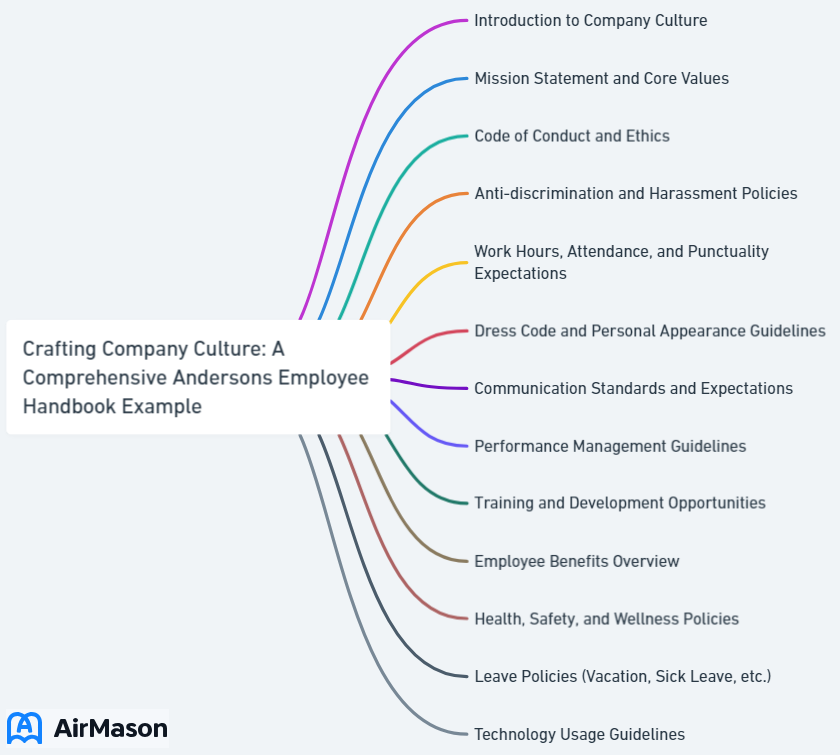
Have you ever wondered what makes a company’s employee handbook exemplary? Look no further than Andersons Employee Handbook Example, a shining beacon of clear communication, fair policies, and robust legal standards. This isn’t just a dry document of rules and regulations; it is a testament to Andersons’ commitment to nurturing a positive work environment, fair dealing, and good faith. Buckle up as we embark on a journey to dissect this paragon of employee handbooks and unearth the lessons it holds for your organization!
Key Takeaways
- Anderson’s Employee Handbook is a comprehensive guide that meets all legal requirements while protecting the company and its employees.
- It contains essential components such as employee resources, standards of conduct, employment policies to create a positive work environment for its employees.
- Crafting an effective handbook requires tailoring it to suit the needs and culture of your company, understanding legal requirements and regularly updating/reviewing it.
Understanding Fair Dealing and Good Faith in Employee Handbooks
An effective employee handbook is not created spontaneously. It is thoughtfully crafted to encapsulate the principles of fair dealing and good faith. But what do these terms imply? Within employment law, fair dealing is the obligation of both employer and employee to interact honestly, fairly, and in good faith. This understanding protects each party’s right to the benefits of the employment contract.
Why do these principles hold such significance in an employee handbook? They set the stage for a level playing field, where both the employer and employee are treated fairly, and employee rights are safeguarded. Imagine a company where trust permeates every interaction, and the service provided is a reflection of this harmony. That’s the kind of productive workplace fair dealing and good faith principles can foster.
The Concept of Fair Dealing
The principle of fair dealing in the employment industry includes:
- Honesty and fairness in the employer-employee relationship
- Treating employees equitably
- Respecting their rights
- Fulfilling contractual obligations
Just as a compass directs a ship, fair dealing navigates the path for employee handbooks, compelling employers to pay and behave equitably and respectfully toward their workforce.
But what does fair dealing look like in a work setting? It’s like a sturdy bridge allowing the use of copyrighted material for criticism, review, or news reporting without permission or payment, under certain circumstances. This balance between the rights of copyright holders and freedom of expression fosters a sense of fairness while respecting the rights of the original creators.
In a nutshell, fair dealing creates a culture of trust, transparency, and mutual respect, a cornerstone of a positive work environment.

The Principle of Good Faith
If fair dealing serves as the compass, good faith acts as the beacon directing the employer-employee relationship. It’s a promise that both parties will conduct themselves honestly and fairly in their contractual relationship. Imagine the ripple effect when trust and transparency become the norm, transforming the workplace into a supportive and collaborative environment where employees are valued and respected.
Good faith in business operations resembles a smoothly operating machine where contractual obligations are met honestly, transactions are conducted fairly, and interactions are free from manipulation. But what happens when this principle is ignored? It’s akin to a machine malfunctioning, leading to loss of trust, lowered morale, and potential legal action.
Therefore, in an employee handbook, it’s critical to assume that employees have honest intentions and treat them with fairness and honesty.
Key Components of Andersons’ Employee Handbook

As we delve into Andersons’ Employee Handbook, we should acknowledge its fundamental components. Much like the ingredients of a well-baked cake, these components work together seamlessly to create a successful handbook. They include:
- Employee resources and IT support
- Standards of business conduct
- Employee code of conduct
- Keys and access requests
These components aren’t just a random assortment of guidelines; they represent a deep commitment to creating a positive work environment, treating employees equitably, and upholding the principles of fair dealing and good faith. This commitment extends to the company’s employment policies and procedures, which unfortunately, aren’t explicitly detailed in the handbook. However, Andersons’ commitment to its employees shines through its policies like Equal Employment Opportunity, Non-Harassment Policy, and Substance Abuse/Possession Policy. These policies act as a compass, directing the organization toward a supportive work environment.
Employment Policies and Procedures
An employee handbook is comparable to a manual for a complex machine. It outlines the working and maintenance procedures to ensure smooth functioning. In Andersons’ handbook, these working procedures are the employment policies like Equal Employment Opportunity, Non-Harassment Policy, and Substance Abuse/Possession.
These policies don’t exist in a vacuum; they are intricately woven into the fabric of the organization. For instance, the handbook provides a detailed procedure outlining work hours and overtime. This ensures that employees are aware of their rights and responsibilities, fostering a sense of transparency and trust within the organization.
Additionally, while the handbook does not provide explicit details regarding Andersons’ policy on paid time off and vacations, it appears that employees are eligible for paid time off which can be used for vacation, short-term illnesses, and other personal reasons.
Code of Conduct and Expected Behavior

The foundation of Andersons’ handbook is the code of conduct and expected behavior. It’s like the DNA of the company, outlining what the company stands for and what it expects from its employees in return. It sets the bar for all employees and covered parties, emphasizing their duty to prioritize the interests of the company in the performance of their duties.
Much as in a well-choreographed ballet, these codes and expectations establish the rhythm for the company’s operations. They emphasize intellectual honesty and integrity in employees’ behavior, both during and after working hours. This sets a high standard for employees, encouraging them to act responsibly and ethically.
Support and Commitment to Employees
If the employee handbook serves as the manual, then the organization’s support and commitment to its employees functions as the fuel that ensures the machine runs smoothly. Andersons’ handbook illustrates this commitment through various policies like the Equal Employment Opportunity, Non-Harassment Policy, and Substance Abuse/Possession policy.
Like a sturdy bridge, the handbook ensures the welfare of its employees by providing a comprehensive benefits package, including affordable healthcare options and other employee resources. It also outlines employee standards and responsibilities, ensuring a safe and respectful work environment. Furthermore, it reflects the company’s commitment to professional growth through policies and programs that support professional development, such as tuition reimbursement for job-related courses, which is a significant benefit.
Corteva Employee Handbook Example
In the context of workplace guidelines and policies, the Corteva Employee Handbook Example serves as an illustrative model for employees within the organization. This handbook embodies the core values and principles that Corteva upholds, providing a comprehensive guide for employees to navigate various aspects of their professional journey. From code of conduct to benefits information, the Corteva Employee Handbook Example encapsulates the company’s commitment to fostering a positive and inclusive work environment. Employees can refer to this handbook for insights into the organization’s expectations, rights, and responsibilities, ensuring a harmonious and informed workforce.
Legal Aspects of Andersons’ Employee Handbook

Walking the tightrope of legal aspects in an employee handbook can be tricky. But Andersons’ handbook does so with aplomb, ensuring that it meets all legal requirements while also protecting the company and its employees. Resembling a fortress, it remains firm, maintaining the company’s commitment to compliance with laws, rules, and professional standards.
But what about the legal landscape of Canada, where Andersons operates? That’s where the handbook takes a deep dive, ensuring compliance with Canada’s Employment Law. It’s a dance that requires finesse, ensuring that the company stays on the right side of the law while maintaining a positive and productive work environment.
Employment Law in Canada
Within the broad spectrum of Canadian employment law, the Employment Standards Act (ESA) presides, encompassing issues such as wages, overtime, leaves of absence, public holidays, vacation, termination of employment, and temporary lay-offs. Additionally, the Canadian Human Rights Act prohibits discriminatory hiring practices based on race, age, sexual orientation, and gender in federal jurisdictions.
Within the orchestration of employment law, the employee handbook plays a pivotal role. While there is no legal mandate for employee handbooks in Canada, they can be legally binding and considered an extension of an employment agreement. It’s a delicate balance, ensuring the handbook accurately reflects current policies and procedures while also complying with Canada’s employment laws.
Protecting Employee Rights and Interests
Regarding employee rights and interests, Andersons’ handbook functions as a mainstay of protection. It safeguards employee rights and interests by adhering to all pertinent local laws and regulations, such as those pertaining to minimum age, minimum wage, and human rights, in order to obtain the best possible working conditions for employees.
Like a well-oiled machine, Andersons enforces these protection measures through various means to ensure a workplace free of discrimination, harassment, or other unfair treatment. Moreover, it prioritizes employee safety by promoting a safe work environment and implementing safety communication practices.
Addressing Employee Concerns and Violations
Addressing employee concerns and violations in Andersons’ handbook requires a delicate balancing act of diplomacy and precision. It sets up a protocol for employees to present complaints to their supervisor in an informal manner for discussion, consideration, and resolution.
But what happens when an employee violates the company’s policies? The handbook outlines clear procedures for handling such violations. It’s like a guardrail, keeping the organization’s operations within the boundaries of fairness, integrity, and honesty.
Tailoring Your Own Employee Handbook: Lessons from Andersons
As we approach the conclusion of our exploration through Andersons’ Employee Handbook, it’s an opportune moment to contemplate the lessons it imparts for your organization. After all, an employee handbook isn’t a one-size-fits-all solution; it needs to be tailored to suit the needs and culture of your company.
Understanding your company’s culture and values, incorporating relevant legal requirements, and regularly updating and reviewing the handbook are all crucial steps in creating an effective employee handbook. It’s like piecing together a jigsaw puzzle, where each piece represents a key aspect of your company.
Understanding Your Company Culture and Values
Comprehending your company’s culture and values is akin to decoding its DNA. It helps you align the content and tone of the handbook with the values, beliefs, and behaviors of your organization, ensuring that the knowledge shared is consistent with your company’s identity.
Your company’s values are the heartbeat of the handbook. They communicate the company’s mission, values, culture, and standards to employees, helping them understand what’s expected of them and how they can contribute to the success of the company.
Incorporating Legal Requirements
Incorporating legal requirements into an employee handbook is comparable to setting up a safety net. It ensures that the handbook is compliant with all relevant laws, protecting your company from potential legal fallout.
Just as a lighthouse navigates a ship, relevant legal requirements light the way for your employee handbook. It’s crucial to include a statement summarizing each policy and procedure in the handbook, and to regularly update it to reflect changes in employment laws or internal policies.
Regularly Updating and Reviewing Your Handbook
Similar to a garden, your employee handbook necessitates regular maintenance and attention for it to flourish. Regular updates and reviews ensure that the handbook accurately reflects current policies and procedures, minimizes the possibility of litigation, and effectively communicates your policies to your employees.
Updating your handbook can be compared to changing the batteries in a flashlight. It ensures that the light continues to shine bright, guiding your employees and staying compliant with the changing landscape of labor laws.
Summary
As we conclude our journey through Andersons’ Employee Handbook, let’s revisit the key lessons. An effective employee handbook is a blend of fair dealing and good faith, clear employment policies, and robust legal protections. It’s a tool that not only communicates company policies but also reflects the company’s culture and values. It’s a compass, guiding employees and fostering a positive work environment. Remember, your employee handbook is more than just a document; it’s a testament to your company’s commitment to its employees and its vision for success.
Lam Research Employee Handbook Example
In this illustrative Lam Research Employee Handbook Example, employees gain valuable insights into the company’s policies, procedures, and expectations. This handbook serves as a comprehensive guide, covering topics ranging from workplace conduct to benefits and beyond. By exploring the Lam Research Employee Handbook Example, individuals can familiarize themselves with the organization’s commitment to fostering a positive and inclusive work environment. Clear communication of roles, responsibilities, and company values is a cornerstone of this handbook, ensuring that employees are well-equipped to navigate their professional journey within Lam Research.
Frequently Asked Questions
What should be in a restaurant employee handbook?
A restaurant employee handbook should include all rules, policies, guidelines and processes, as well as the mission statement and team culture, to ensure employees are aware of the unique aspects of the restaurant.
What is in an employee handbook sample?
The Employee Handbook provides an introduction to the company and covers employment basics, workplace policies, code of conduct, compensation, benefits, working hours, and termination procedures. It serves as a guide for employees, answering many of their questions related to employment.
Can I ask to see the employee handbook?
It is a good idea to ask to see the employee handbook before signing any agreements; this may provide important information regarding workplace rights and it can benefit both you and your employer. Furthermore, workplaces that respect employees generally expect team members to act in the company’s (and their colleagues’) best interest. Asking to see the handbook is a wise decision and you will be glad you did.
What is the concept of fair dealing in an employment context?
Fair dealing in an employment context is the principle of acting honestly and in good faith within the employer-employee relationship. It seeks to ensure mutual respect and a positive work environment.
What is the significance of comprehending corporate culture in crafting an employee handbook?
Comprehending corporate culture is essential in crafting an employee handbook, as it helps ensure the content and tone are aligned with the company’s values, beliefs, and behaviors.
Important Disclaimer:
The article presented here does not serve as a representation of the company’s actual employee handbook mentioned in this article.
Our discussions and insights regarding employee handbook are based on assumptions about what may be considered significant in the companies’ policies. These assumptions are drawn from available information and industry knowledge. Readers are advised that the content provided is for informational purposes only and should not be construed as an exact reflection of any company’s official policies or procedures. For precise and accurate details regarding a company’s employee handbook, individuals should refer directly to the company’s official documentation or consult with appropriate representatives.
Please be aware that the content on this page has been generated by using artificial intelligence language models and may contain errors, inconsistencies, or outdated information. It is provided as-is without any warranties or guarantees of accuracy. We strongly recommend using this content as a starting point for further research. We disclaim any liability for damages or losses resulting from the use or reliance on this content.